8 December, 2003
Success!
It is just 2 days shy of one month since I left Peru, N.Y. on this expedition and today, we finally got to do what we came here to do.
We got up early this morning to make the first flights out of the Beardmore camp, and even though the 212 helicopter could carry four passengers, we were told we had to go in groups of two, this was made necessary because our landing zone was so high (12,450 feet) and also, extra caution was being exercised due to the accident at the beginning of last week. Dr. Hammer and Peter Braddock went first and within 40 minutes of taking off, we got a radio call from Dr. Hammer "We have bones!" He also mentioned almost as an after thought, the weather was good and all is well. That last piece of news is sort of strange because you would have thought the weather would be worse up high but the winds here are often driven down the valleys and are localized, and so it was today. At the Beardmore Camp, the winds were 20 kts and it was 15 degrees F with blowing snow (rearranging existing snow). On the Kirkpatrick site, it was 3 kts. and 5 degrees F. cold, but sunny so it was quite pleasant.
Kevin Kruger and I were the last to go. We brought with us the rock saw, which would be needed to extract the bones and our daypacks. The ride there was breath taking, nunatuks popping out of glaciers that stretched as far as the eye could see. Hugh mountains rising up, walling the side glaciers that flowed into the Beardmore. Ice falls thousands of feet high with crevasses of deep blue splintering them into a patchwork of blocks. And all around us blue sky, the cleanest clearest blue sky you could imagine only punctuated by the Sun, which was working its magic all over the Antarctic wilderness.
As I looked at this scene from my seat in the helicopter, I remembered we saw a skua this morning while we were waiting for our flight. The skua is sort of Antarctic seagull, bigger and a touch more brown in its plumage. As we watched this bird fly south, we wondered how could a bird be so far from its food source, in this case the open water of McMurdo Sound where it could find small fish or scavenge for food around the town. In the air, I could not see anything that a bird could use for food in any direction. What could cause a bird to wander so far? How can it sustain itself so far from food? I was happy to know that the "bird" I was in carried survival bags, in case we were forced down away from our source of food and shelter, we are definitely the weaker species.
Our landing on Kirkpatrick was a bit tenuous; the pilot was not happy setting down on the slope at high altitude so after several tentative touchdowns with small maneuvers in between, he finally set it down and gave us the sign to disembark. We pulled our gear off the machine, and after making eye contact with the pilot, who motioned to us where we could walk safely, we left the LZ (landing Zone).
We were just around the corner from the original dinosaur find so we dropped our packs and went to right to work with the rest of our team. I noticed Peter was missing and Dr. Hammer said he was off looking at other formations. Shortly there after, Peter returned to our digs and asked Drs. Curie and Hammer take a look at the rock he was holding. It did not take them long to determine it was fossilized bone and asked him where he found it. Peter did better than that, he took all of us there and we saw a large, triangular bone fragment and another long bone under it. It is still too soon to tell but we may have a new addition to the Kirkpatrick dinosaurs and I dare not say more so not to jinx it.
While Kevin and Nate worked at removing Peter's find, the rest of us went through the skree to look for Cryolophosaurus's bones that were overlooked the last time the site was visited. They found the dinosaur at the end of the previous field trip and had to leave in a hurry, in fact the rock splitting tools were still stuck in the rock where they left them years before. They looked brand new, not a speck of rust could be seen on any of them. There even was a roll of toilet paper on the ground, (used for wrapping bone fragments among other things.) which was in great shape.
We spent almost 8 hours up there and were very happy not to have anyone come down with altitude sickness. We all did experience shortness of breath upon exertion but other than that we were in great shape. We found out that other parties at lower elevations did not fare as well today so we count ourselves as lucky, or maybe the half a tab of Diamox we took before we commenced work that did the trick.
We found about 50 fragments before we had to leave for the day so we came back to camp with renewed spirits due to a successful first day of work and of course, Peter's good fortune.
So friends, wish us fair skies and good hunting on what the helicopter pilots have come to call Dinosaur Mountain.
Cheers,
Andy

Peter Braddock celebrates his fossil find. Do I hear "-Braddocki?"

The purple rock between the tools is the Cryolophosaurus. Note the altitude reading on my watch.(12.470')
Contact the TEA in the field at
.
If you cannot connect through your browser, copy the
TEA's e-mail address in the "To:" line of
your favorite e-mail package.
|
